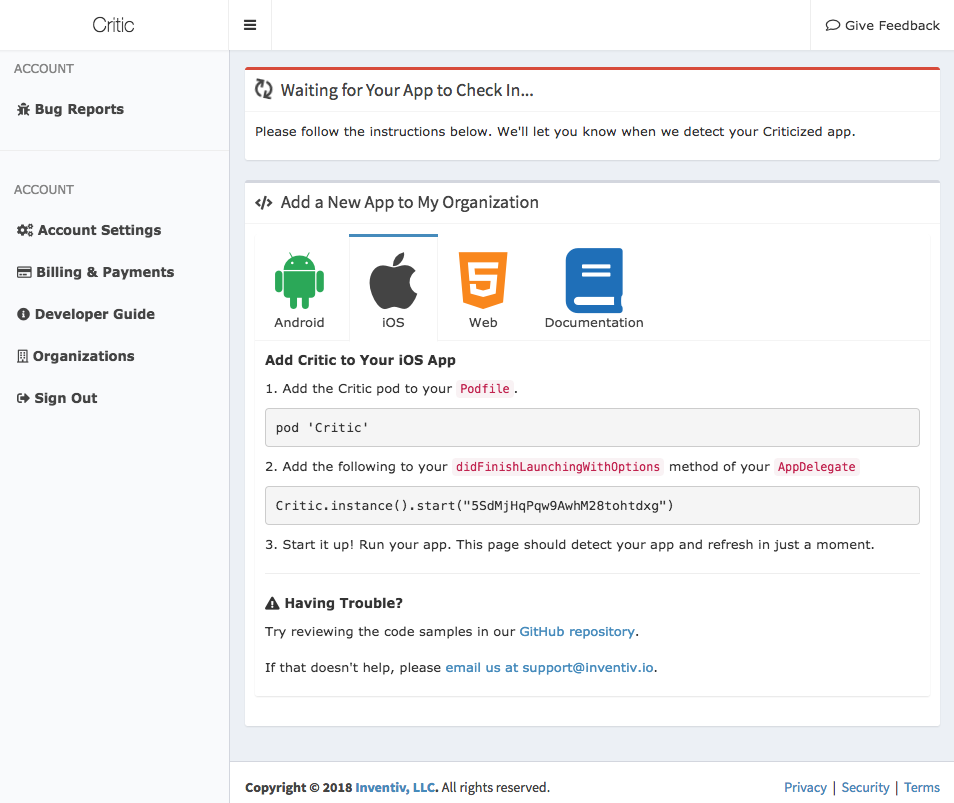Table of Contents
Recent User Feedback on Critic
I’ve been asking several users what they think of Critic. I want to know whether it meets their needs for receiving and responding to bug reports and customer feedback. This has caused me to make a few changes to the registration process, new user onboarding, and the data provided by mobile client libraries. I’ve now released a new onboarding experience, changes to the Critic web portal, and updates to mobile client libraries. Sign in to Critic to check everything out!
New Onboarding Experience for New Users
I previously noticed a drop-off in potential users during the registration experience. While this is to be expected to some degree, I felt like I could improve the signup experience a bit and improve conversions.
I also found room for improvement in the general onboarding experience after users successfully sign up. Previously, a notification-stuffed “getting started” wizard led you through setting up an Organization and Product. It then gave you an API access token and sent you to another page to figure out how to integrate Critic with your app. Ugg. So I did away with all of that. Now, in the new onboarding experience, you see this as soon as you sign up:
 Critic's new onboarding experience gives you integration instructions right away
Critic's new onboarding experience gives you integration instructions right away
Right away you see how to add Critic to your app. Additionally, instructions are customized to your account. That is, the API token in the code snippet is your API token. Simply paste the code into your app and you are done. Also, that “Waiting for Your App to Check In” message automatically goes away once you get an app running with Critic. Once an app checks in, you will see it at the top of the page.
This new onboarding experience eliminates the concept of “Products” within Critic. The nomenclature differed from what most people are used to (“apps”). Therefore, we now have Apps. Apps check in automatically. No more arduous setup process for every new app you want to support. Just follow the instructions in the web portal to get new apps to check in. Information about your app, including its name and current version number, will magically show up in Critic.
Other Web Portal Updates
The new onboarding experience gave me an opportunity to add some more information to bug reports as well. Now, devices check in on startup with critical information such as the device battery level, memory usage, and storage space. Additionally, we track application installs and application version histories for each device. Every bug report now includes updated device status information (battery, memory, and storage information). You can review this information alongside other troubleshooting info on the actual bug report in the web portal.
Basic analytics for each app are also present in the web portal. You can see what device models, OS versions, and app versions are most popular with your user population. This is currently includes historical app installs. Future updates will include more granular reports such as current active app installs so you can analyze retention and upgrade paths.
Mobile Library Updates
To make all of this magic happen, I updated the Android and iOS libraries for Critic. You can find the latest versions on GitHub or follow the instructions in the Critic web portal. Mobile apps will now check in with our service on app startup. This gives us the aforementioned device statistics and app install information we share with you in the Critic web portal. If you’re curious about the specific data being gathered, the libraries are open source so you can review exactly what’s happening.
Existing Users
If you’re already using Critic, don’t worry! Your apps will continue sending bug reports just fine, no changes needed. While eventually the older versions of libraries and API endpoints will be removed, for now they continue to function as they always have. However, it is worth your time to upgrade your apps when you get a chance. The new mobile libraries give you more data points to help diagnose software problems.
Try Critic Bug Reporting Today
Sign up for Critic today and receive a free trial. It just takes a minute to integrate Critic into your app. The feedback you will receive from customers will make it well worth your time.